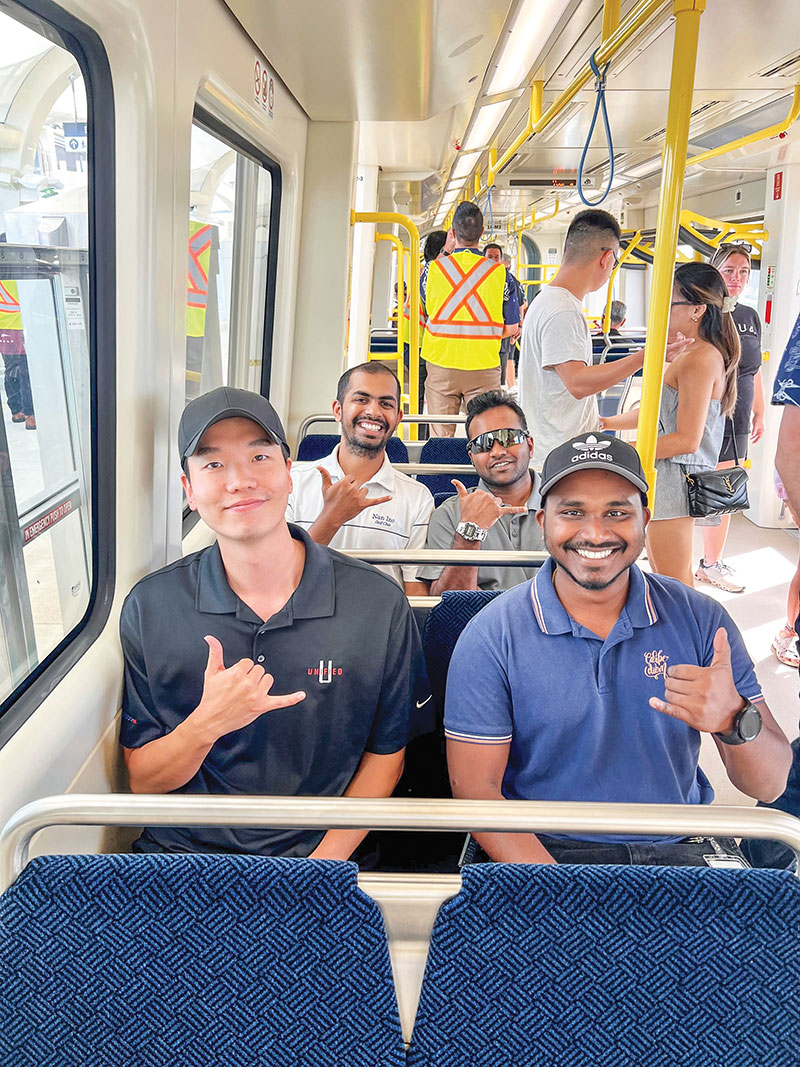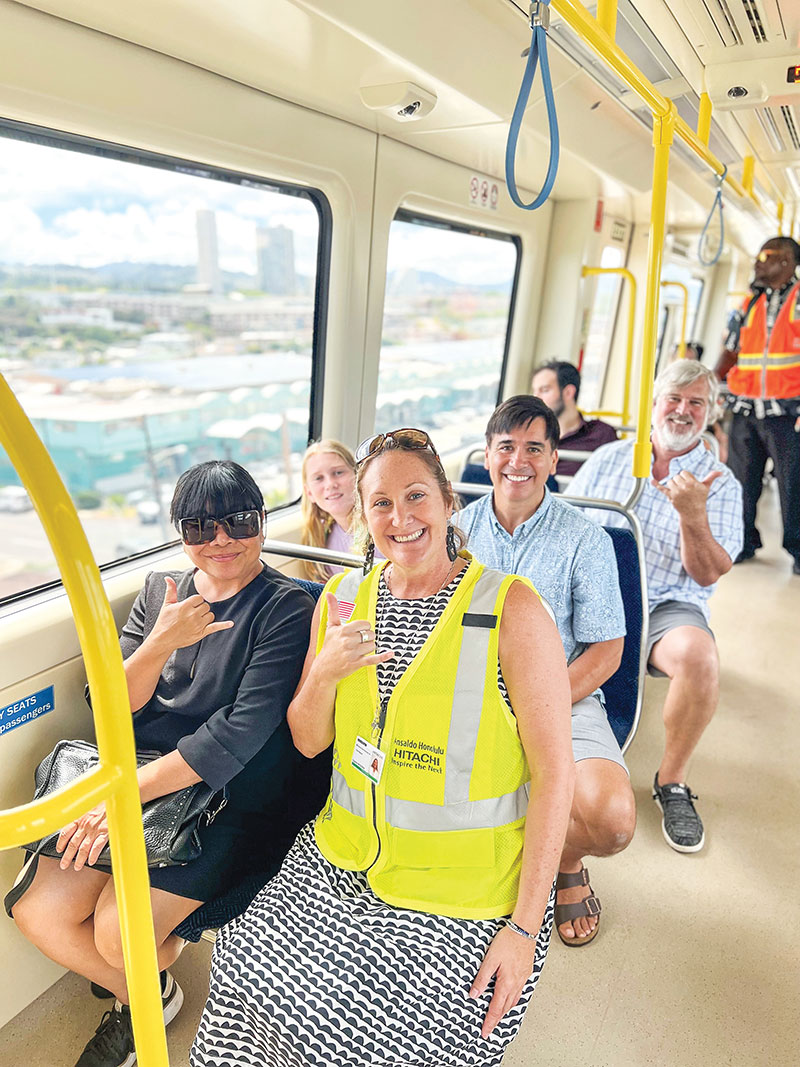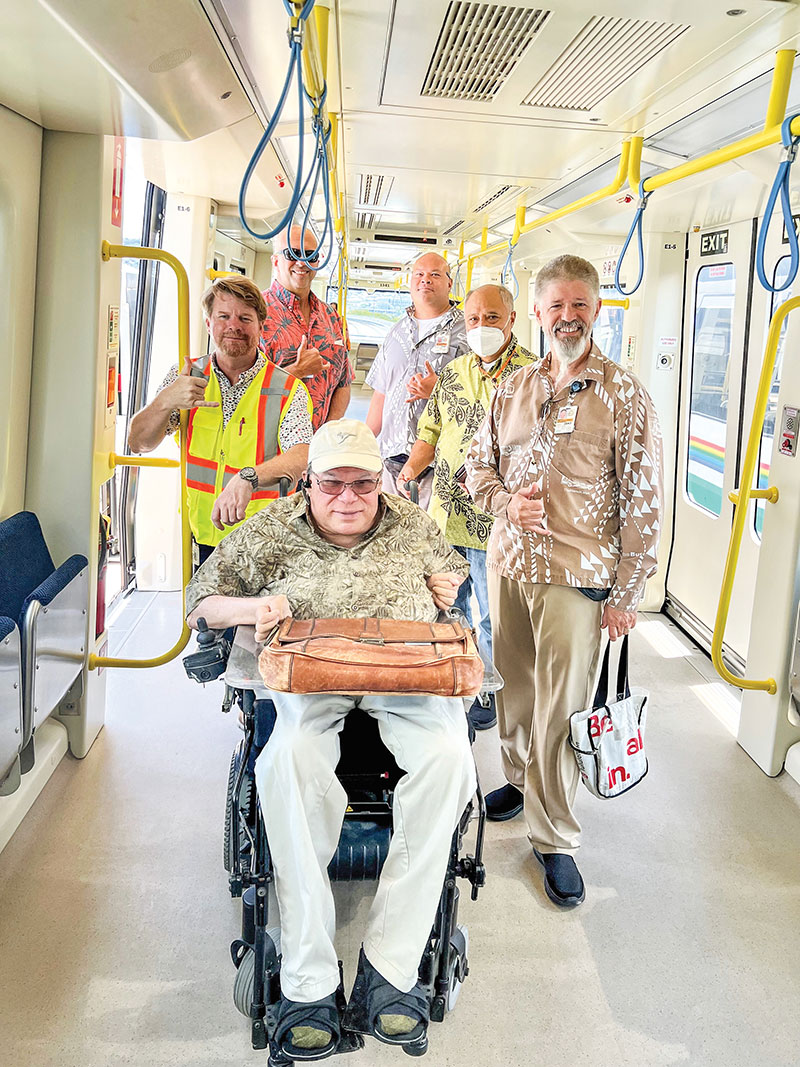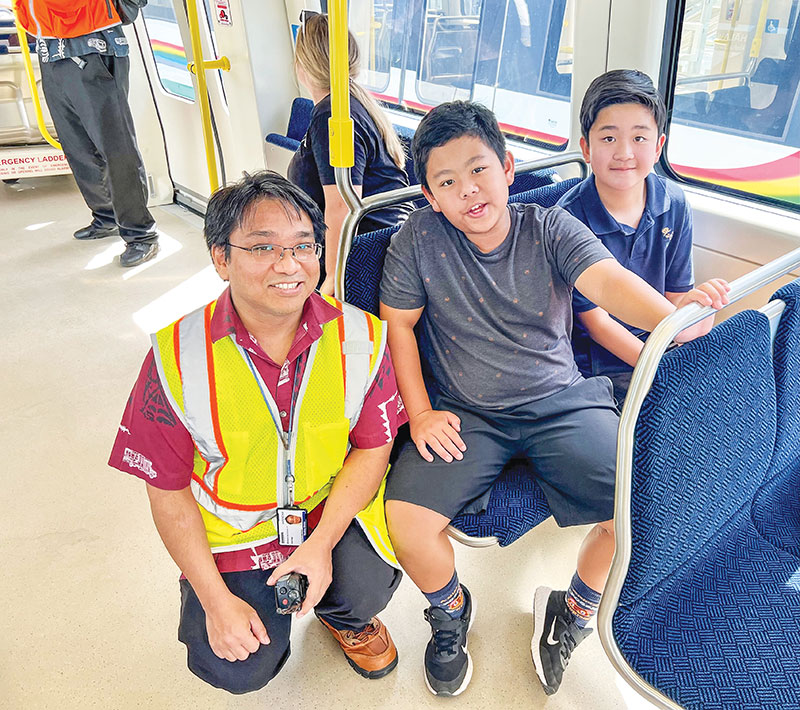All Aboard!
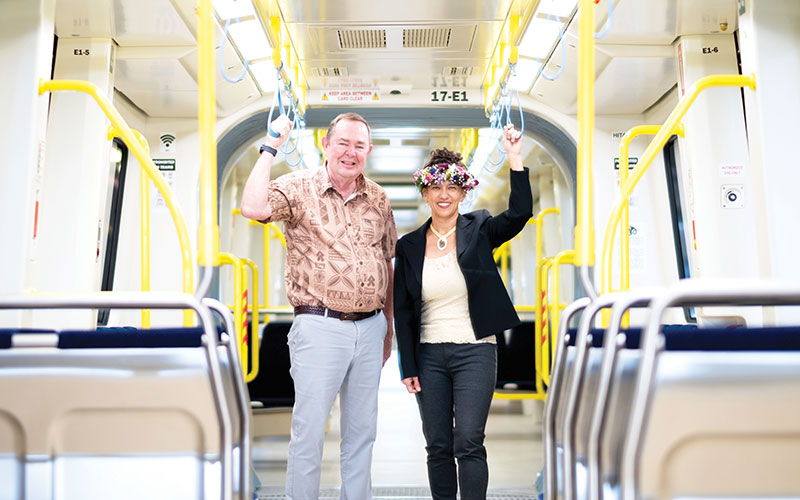
Skyline remains in good hands thanks to Roger Morton, director of Honolulu Department of Transportation Services, and Lori Kahikina, CEO of Honolulu Authority for Rapid Transportation. PHOTO BY ANTHONY CONSILLIO
Hawai‘i rides into the future with its long-awaited rail system known as Skyline.
Years of hard work have finally come to fruition as the rail project, Skyline, officially opens to the public.
Riders can board the elevated rapid transit system for free from 2 to 6 p.m. on June 30. To continue the celebration, guests can travel free of charge with a HOLO card, a contactless smart card used to pay for public transportation fares in Hawai‘i, from July 1 to 4.
As with any new endeavor, the Skyline project has had its fair share of challenges. Fortunately, Lori Kahikina has been up to the task.
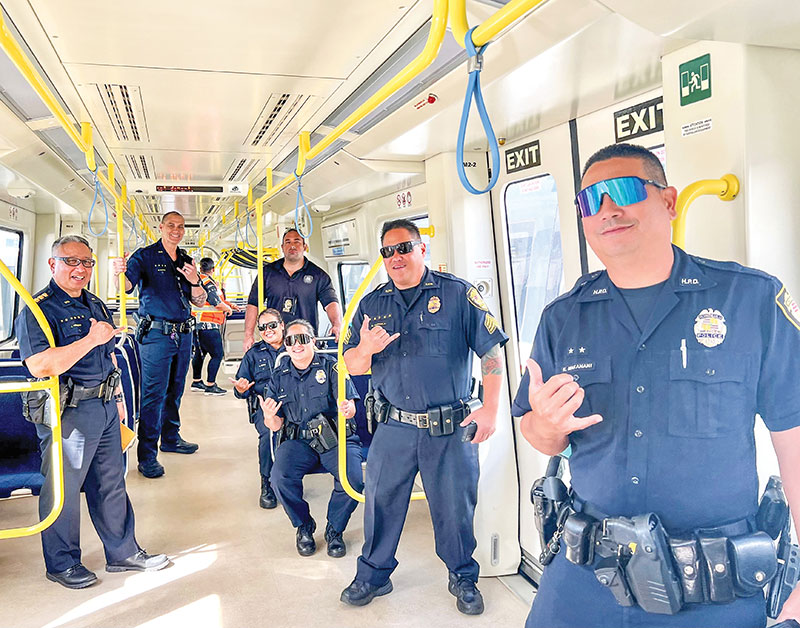
Skyline contains more than 100 seats and enough standing room to accommodate 500-plus riders. PHOTO COURTESY HITACHI RAIL HONOLULU/CARA MAZZEI
The Kamehameha Schools and University of Hawai‘i at Mānoa alumna took over as executive director and CEO of Honolulu Authority for Rapid Transportation two and a half years ago. But Kahikina is not new to serving the community, as she’s been working for the city for more than 15 years, most of it with its environmental services department.
From being over budget to being behind schedule, the Skyline project has faced backlash and doubt from the community. Kahikina admits that her own family and friends were surprised when she decided to join HART as its new leader.
Still, she insists she paid no mind to the naysayers, believing she could make a positive impact on the project. And Kahikina did just that, noting that her team has met all the deadlines promised to the community.
“Always do what’s in the best interest of the taxpayers — that’s the culture I instilled at HART,” Kahikina says. “You can’t go wrong if that’s what’s leading you, if that is what’s directing you.”
While most people shy away from problems, Kahikina believes in facing them head on. As an engineer, she naturally has a love for problem-solving and admits that finding solutions is her favorite aspect of the job.
“We do encounter various technical issues. It’s a major infrastructure project, so solving those technical issues is the fun part for me,” she shares.
Kahikina’s humble demeanor shines through when acknowledging the Skyline project is what it is today because many hands have played integral roles behind the scenes.
“I’m not the smartest one here. That’s what all the technical and subject matter experts are here for at HART,” she says. “As a leader, it’s my job to push, and whenever something gets stuck, help things get unstuck.
“We get everyone in the same room and collectively find a solution, and then we implement it,” Kahikina continues. “What’s very key, is HART doesn’t make those decisions in a vacuum. We have all of our stakeholders at the table.”
Leading HART’s sister agency, Honolulu Department of Transportation Services, is director Roger Morton. While Kahikina and her team at HART are responsible for constructing the rail’s infrastructure, Morton’s group is in charge of maintaining and operating Skyline. Together, they tackle any problems.
Kahikina admits it was a bittersweet moment when she handed Skyline’s first segment over to the city earlier this month.
“Working with Roger and DTS is just a tremendous partnership,” she says. “When an issue comes up … they bring up their concerns. We got to make sure we address their concerns, solve it cohesively as a team, and then move forward. They’ve been terrific partners.”
Morton shares similar sentiments and notes that Kahikina’s previous experience with large construction projects made her the perfect fit for the job.
“We meet on a regular basis. I have nothing but admiration for her,” says Morton, who like Kahikina has been in his role for more than two and a half years. “She has a big job in order to build the system, and I have a pretty big job, too, in order to run it right.”
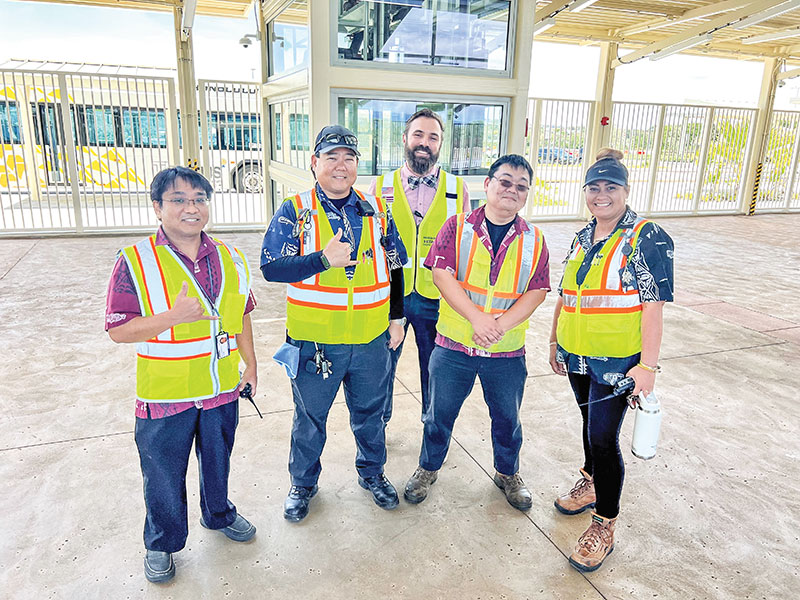
Skyline station workers get ready to greet passengers. PHOTO COURTESY HITACHI RAIL HONOLULU/CARA MAZZEI
As director, Morton’s job of operating and maintaining Skyline may seem daunting, but his career in transportation speaks for itself. From starting off as a mechanic’s assistant and taxicab driver to being a city traffic technician and then president of O‘ahu Transit Services, which oversees TheBus, Morton’s passion for all things transit is clear.
“The best part about my current job is being able to have a vision for what our city could look like and try to put in programs that make it happen,” he shares. “And it’s not for the money — it’s for the love of what we do. As the director, it gives you the opportunity to shape the way policy can evolve and actually have projects that’ll make a difference for people for generations to come.”
The Skyline project has more than 15 trains in its arsenal, with each comprised of four cars. Unlike traditional trains that feature separate cars, Skyline’s cars are connected together seamlessly, allowing riders to make their way through the length of the train without walking through multiple doorways.
At approximately 10 feet wide and more than 200 feet long, Skyline contains more than 100 seats. However, including standing room, the train can accommodate more than 500 riders. Priority seats are also available for kūpuna and those with wheelchairs. The air-conditioned train is equipped with bike racks and overhead storage.
Skyline’s infrastructure itself is a work of art. Certain columns feature embossed artwork, which tell the story of that ahupua‘a, or land division. Its architectural system boasts more than 1,500 security cameras, which are dispersed throughout the trains, transit stations and park-and-ride lots.
Skyline’s operational control center monitors the various cameras to ensure all goes smoothly. In the event of an emergency, passengers can use Skyline’s intercoms to call for assistance.
The initial segment of the Skyline system spans 11 miles from East Kapolei to Aloha Stadium, and the commute takes about 21 minutes in each direction. In addition to bypassing traffic, Skyline offers riders a whole new vantage point with some areas being up to 30 feet above ground.
“(The name) is reflective, we think, of really what you’ll see from the system,” Morton explains. “First of all, because it’s an elevated system it does become part of our skyline. But also, as you ride on, you’re going to see a totally different view of the city that you don’t get when you’re driving at street level in a car.”
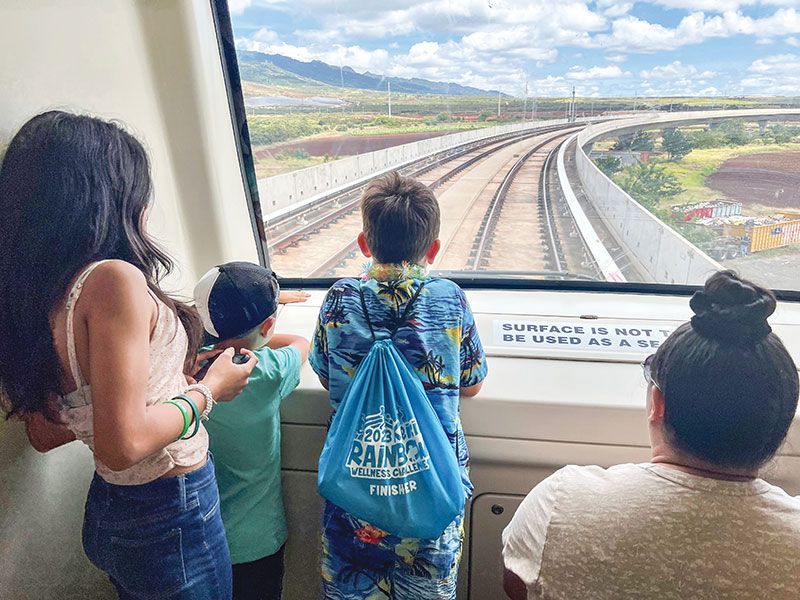
Riders can enjoy a new vantage point while riding Skyline. PHOTO COURTESY HITACHI RAIL HONOLULU/CARA MAZZEI
Skyline fares follow the same structure as TheBus, with daily and monthly passes available.
“If you’re on a bus, you can transfer to rail. If you start on rail, you can transfer to bus,” Morton explains. “If you start on bus, you can transfer to rail, then you can transfer to bus. We’re going to do our best to make it as seamless as possible.”
On the Skyline’s grand opening, Morton believes “it’ll be a milestone in our city’s development.”
“Skyline is not just for today, Skyline’s for the future as well,” Morton continues. “We have already permitted about 30,000 dwelling units in the west of O‘ahu. Each household might generate five, or six, or seven trips per day. I think that’s what the real value of Skyline will be because there’s no way that our H1 highway and our other arterial roads will be able to accommodate that level of additional trip making.”

A family stands in front of an embossed Skyline column, which features artwork unique to that ahupua‘a, or land division. PHOTO COURTESY HITACHI RAIL HONOLULU/CARA MAZZEI
Both Kahikina and Morton encourage the community to experience Skyline’s transit system.
“I do want everybody on the island to have the opportunity to ride and see this system,” Morton says. “You paid for it. It’s been a long time coming. I think they’ll be impressed by just the engineering and the styling of the trains, and just the whole thing.”
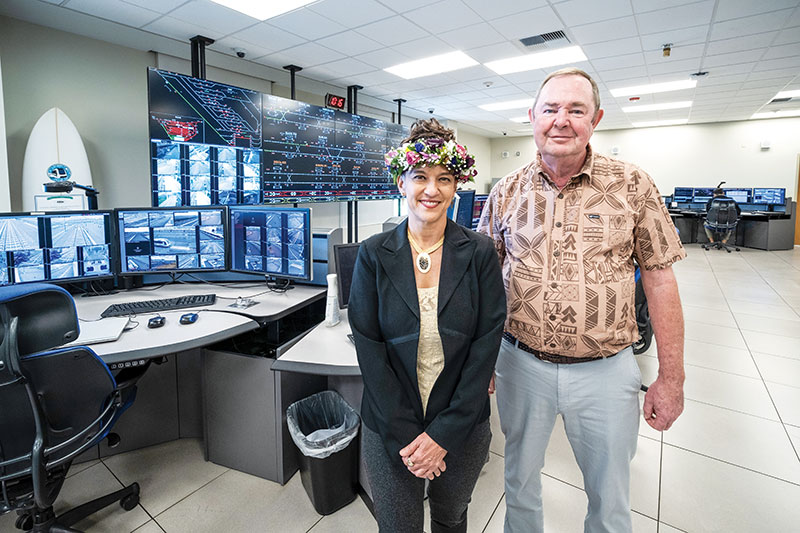
Lori Kahikina and Roger Morton pose in Skyline’s operational control center, which monitors the system’s various security cameras. ANTHONY CONSILLIO PHOTO
Adds Kahikina, “I’m just really appreciative of the community’s patience and am excited for them to get onto the system and be as excited as we are about it.”
Skyline operates from 5 a.m. to 7 p.m. Mondays-Fridays, and 8 a.m.-7 p.m. on weekends and holidays. For more information, visit honolulu.gov/skyline.


